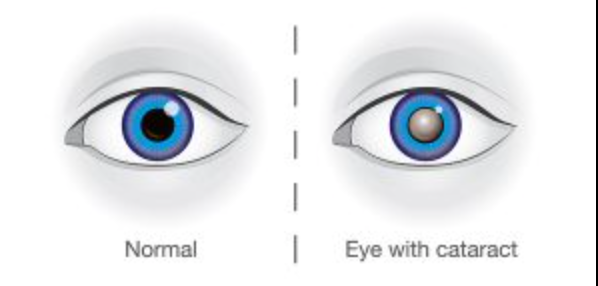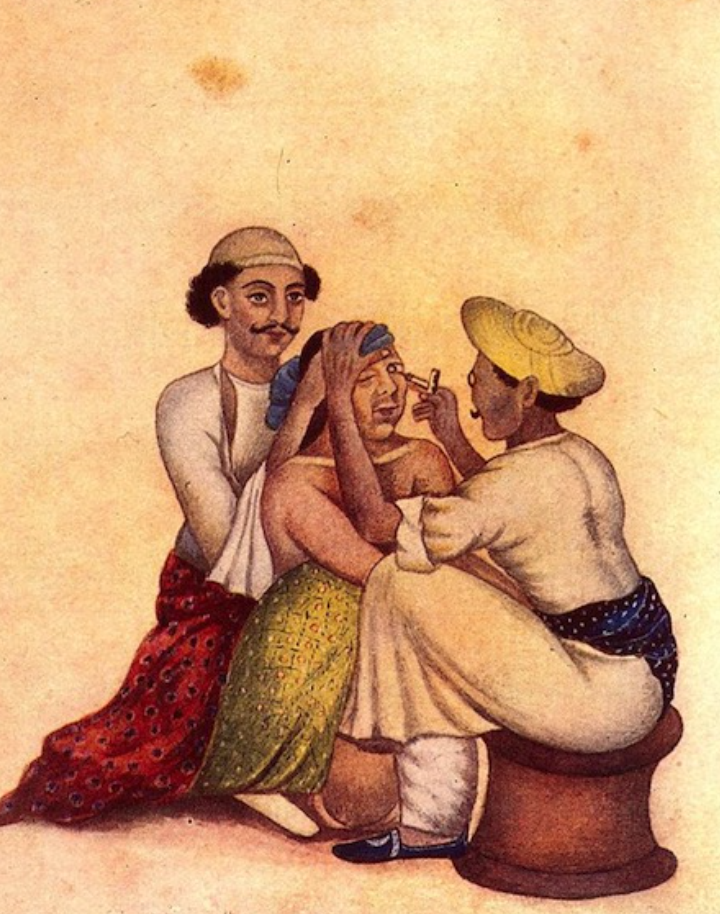A cataract is a common eye condition that causes clouding of the lens inside the eye, leading to blurred or decreased vision. The lens, located behind the iris and the pupil, is normally clear and helps to focus light onto the retina at the back of the eye, allowing us to see sharp images. However, when a cataract develops, the lens becomes cloudy, scattering the light entering the eye and making it difficult for the retina to receive a clear image.
Globally, cataract is one of the leading causes of vision impairment with over 65 million people affected by it (WHO World Report on Vision 2019).
Image 01: To show what someone with blindness can see, the International Agency for the Prevention of Blindness created the image below.

What causes Cataracts?
Cataracts can stem from various factors, with aging being the most common trigger. As individuals age, the proteins within the eye's lens may aggregate, leading to opacity and vision impairment. This natural aging process predominantly contributes to cataract development in older individuals. As the lens becomes denser and cloudy over time, visual acuity diminishes, potentially hindering daily activities and independence. While cataracts are commonly associated with aging, they can also occur in other age demographics.
Some individuals are born with congenital cataracts, necessitating prompt detection and intervention to prevent permanent vision loss.
Additional causes of cataracts encompass eye trauma, inflammation, underlying health conditions like diabetes, specific medications such as steroids, tobacco usage, exposure to ultraviolet (UV) radiation, and genetic disorders.
Image 02: The difference between a normal eye and an eye with cataract

Is there any treatment?
The most common treatment is surgery to remove the cloudy lens and replace it with an artificial intraocular lens (IOL). This surgery is typically safe and highly successful in restoring vision. In some cases, especially in the early stages, vision aids such as eyeglasses or magnifying lenses may temporarily improve vision. However, surgery remains the primary treatment for cataracts when they significantly impair vision and impact daily activities.
Image 03: A patient that received a cataract surgery

History of Cataract Surgery
The term "cataract" originates from the Greek word "katarrhaktēs," meaning "waterfall," possibly referencing its opaque appearance resembling rushing water. Cataracts have been documented throughout human civilization, and cataract surgery may have been one of the earliest medical conditions attempted to be treated surgically.
The earliest known surgical attempt dates back to the 5th century BC, employing the "couching" technique. This involved inserting a needle into the eye to dislodge the cloudy lens from the visual axis, temporarily improving vision albeit with significant blurriness due to the lack of lens focusing power. Despite temporarily alleviating the blockage of light, the retained lens and inadequate hygiene often led to severe complications and blindness shortly after the procedure.
Unfortunately, couching is still practiced in some developing countries today due to limited access to eye care services. Cataract surgery saw improvement in 1747 when French Ophthalmologist Jacques Daviel successfully removed the cataract from the eye instead of just dislodging the lens. However, without an available implant to replace the lens, patients relied on extremely strong prescription spectacles post-surgery, resulting in thick glasses.
Renowned Impressionist painter Claude Monet developed cataracts in his mid-fifties, impacting his vision and color perception, evident in the increasingly yellowed palette of his artwork during that time. He underwent cataract surgery on one eye in 1923, and with the aid of thick glasses, his vision significantly improved, allowing him to return to his earlier artistic style with paintings resembling his pre-cataract work.
A significant advancement occurred in the 1940s with the development of an implant to replace the cataractous lens using polymethylmethacrylate (PMMA). English Ophthalmologist Sir Harold Ridley observed that British Royal Air Force Flight Crew with eye injuries from shattered airplane windshields tolerated small pieces of PMMA (Perspex) in their eyes. This led to the realization that Perspex could be an ideal material for making an artificial lens (IOL), with the first successful IOL surgery performed in London in 1949.
Today, sophisticated foldable IOLs are utilized globally, and surgical techniques continue to advance.
Image 04: A cataract surgery couching by Indian doctors

"Please note: The content on this page is intended for general informational purposes only and should not be considered medical advice. For personalized medical advice, please consult with your healthcare professional."

Comentarii